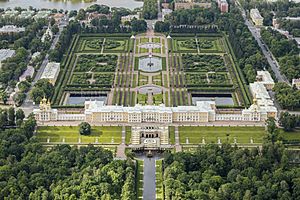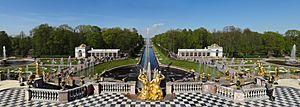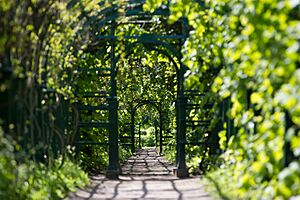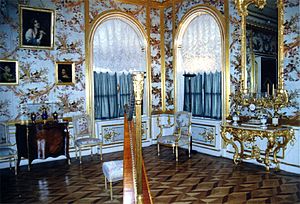Peterhof Palace facts for kids
| UNESCO World Heritage Site | |
|---|---|
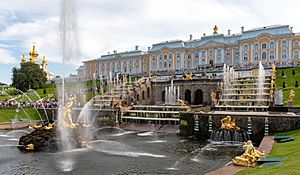 |
|
| Official name | Historic Centre of Saint Petersburg and Related Groups of Monuments |
| Criteria | Cultural: (i)(ii)(iv)(vi) |
| Inscription | 1990 (14th Session) |
| Area | 3,934.1 ha |
The Peterhof Palace is a stunning collection of palaces and gardens in Petergof, Saint Petersburg, Russia. It was built for Peter the Great, a famous Russian ruler, who wanted a grand country home. He was inspired by the amazing Palace of Versailles in France, built by Louis XIV of France.
Peter the Great started planning Peterhof in 1709. After visiting the French royal court in 1717, he decided to make Peterhof even bigger and more impressive. This is why it's often called "The Russian Versailles." The main architect, Domenico Trezzini, worked on it from 1714 to 1728. His style, called Petrine Baroque, became very popular in Saint Petersburg. The gardens were designed by Jean-Baptiste Alexandre Le Blond, who had worked with the famous Versailles landscaper, André Le Nôtre. Later, from 1747 to 1756, Francesco Bartolomeo Rastrelli expanded the palace for Empress Elizabeth of Russia. Today, Peterhof is a UNESCO World Heritage Site, recognized for its historical and cultural importance.
Contents
Building Peterhof
After the Great Northern War ended in 1721, Russia gained control of much of the Baltic Sea coast from Sweden. Peter the Great had already started building his new capital, Saint Petersburg, in 1703. This new city gave Russia important access to the Baltic Sea through the Neva River. The nearby Kotlin Island and its fortress, Kronstadt, also provided a key gateway and harbor.
Throughout the early 1700s, Peter the Great worked to modernize Russia. Building and expanding the Peterhof Palace complex was a big part of his plan to bring Western ideas and styles to his country.
Monplaisir Palace
In 1714, Peter the Great began building the Monplaisir Palace. Its name means "my delight" in French. Peter himself drew sketches for the palace, even deciding on its layout and some decorations. This palace was designed in a Dutch style and served as Peter's summer getaway. He used it when traveling to and from Europe through the Kronstadt harbor.
Inside Monplaisir, Peter displayed many paintings he brought from Europe. He even had a special Maritime Study where he could see Kronstadt Island and Saint Petersburg. Later, Peter decided to build a much larger royal estate with palaces and gardens further inland. This grander project, inspired by Versailles, became the Peterhof Palace we know today.
Peterhof's Design
Peterhof is built on a 16-meter-high cliff, very close to the sea. The Lower Gardens, which cover most of Peterhof's land, are located between this cliff and the shore. They stretch for about 200 meters east and west. Most of Peterhof's famous fountains are found here, along with smaller palaces and buildings. To the east of the Lower Gardens is Alexandria Park, which has 19th-century buildings in a Gothic Revival style.
On top of the cliff, right in the middle of the Lower Gardens, stands the Grand Palace. Behind it, to the south, are the smaller Upper Gardens. Below the palace, on the face of the cliff, is the Grand Cascade. This cascade and the Grand Palace are the most important parts of the entire Peterhof complex. At the bottom of the Grand Cascade, the Sea Channel begins. This channel, one of the largest water systems from the Baroque period, cuts through the Lower Gardens.
The Grand Cascade and Samson Fountain
The Grand Cascade was inspired by a similar one built for Louis XIV of France at his Château de Marly. At the center of the cascade is a man-made grotto, or cave, made of brown stone. It now holds a small museum about the history of the fountains.
The Grand Cascade has 64 fountains. Their water flows into a large, half-circle pool at the end of the Sea Channel. In the 1730s, the huge Samson Fountain was placed in this pool. It shows the hero Samson opening the jaws of a lion. This statue represents Russia's victory over Sweden in the Great Northern War. It's also symbolic because the lion is on Sweden's coat of arms, and a major victory in the war happened on St. Sampson's Day. A powerful jet of water, 20 meters high, shoots from the lion's mouth. This is the tallest fountain in all of Peterhof. The original statue was taken by German forces during World War II, but a copy was put in its place in 1947.
One of the most amazing things about Peterhof is that all the fountains work without any pumps! Water comes from natural springs and collects in reservoirs in the Upper Gardens. The difference in height creates the pressure that makes most of the fountains in the Lower Gardens, including the Grand Cascade, spray water.
The Lower Gardens
The Lower Gardens are designed in the formal style of 17th-century French gardens. Many trees have grown quite large over time. However, in recent years, the trees along the many pathways have been carefully trimmed again. This helps to bring back the original look of the garden. The many fountains here are known for their creative designs.
The same cliff that holds the Grand Cascade also features two other unique cascades. To the west of the Grand Palace is the Golden Mountain. It has beautiful marble statues, which are different from the many gilded (gold-covered) figures of the Grand Cascade. To the east is the Chess Mountain. This is a wide slide with black and white tiles, like a chessboard. Two of the most important fountains in Peterhof are named 'Adam' and 'Eve'.
The Grand Palace
The Grand Palace is the largest palace at Peterhof. It looks very impressive from the gardens, but it's actually quite narrow inside.
The Chesma Hall is decorated with twelve large paintings of the Battle of Chesma. This was a huge naval victory for Russia during the Russo-Turkish War, 1768-1774. A German artist named Jacob Philipp Hackert painted these between 1771 and 1773.
The East and West Chinese Cabinets were decorated between 1766 and 1769. They were designed to show off beautiful art from the East. Russian artists decorated the walls with patterns that looked like Oriental designs. They also hung Chinese landscape paintings in yellow and black lacquer. Another room, right in the center of the palace, is called the Picture Hall.
Other Important Buildings
The Grand Palace is not the only historic royal building at Peterhof. The palaces of Monplaisir and Marli, along with a special building called the 'Hermitage', were all built during Peter the Great's time.
Peterhof's History
Early Years (1705–1755)
In the early 1700s, Peterhof looked quite different from how it does today. Many fountains had not yet been built. The entire Alexandrine Park and Upper Gardens did not exist. What is now the Upper Gardens was used to grow vegetables. Its ponds, which only had three at the time, were used for fish. The Samson Fountain was not yet in the Sea Channel, and the channel itself was used as a grand entrance for boats.
A major change to Peter's original design was making the Grand Palace the most important and prominent building. The Grand Palace was first called simply 'Upper' and was not much bigger than other buildings in the complex. Wings were added between 1745 and 1755. This was one of many projects ordered by Empress Elizabeth of Russia from the Italian architect Bartolomeo Rastrelli. The Grand Cascade also had fewer decorations when it was first built.
World War II and Restoration
Peterhof was taken by German troops in 1941 and held until 1944. Before the German army arrived, workers tried to save as many treasures as possible. They managed to save some of the palace's valuable items and tried to hide the fountain sculptures. However, three-quarters of the sculptures, including all the largest ones, remained in place.
On September 23, 1941, German troops captured Peterhof. The German army caused great damage to Peterhof. Many fountains were destroyed, and the palace was partly blown up and left to burn.
Restoration work began almost immediately after the war ended in 1945. The Lower Park was reopened to the public that same year. Restoration efforts continue even today to bring Peterhof back to its original beauty.
In 1944, the name was changed to "Petrodvorets" (meaning "Peter's Palace") due to strong feelings against Germany during the war. However, the original name, Peterhof, was restored in 1997 by the Russian government. Peterhof was built to celebrate Russia's access to the Baltic Sea.
Images for kids
See also
 In Spanish: Palacio de Peterhof para niños
In Spanish: Palacio de Peterhof para niños
- List of Baroque residences
- Medici lions; the inspiration for the palace's Lion Cascade
- Peter the Great Statue
- Historic Centre of Saint Petersburg and Related Groups of Monuments
- List of World Heritage Sites in Russia
- Seven Wonders of Russia


